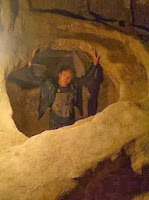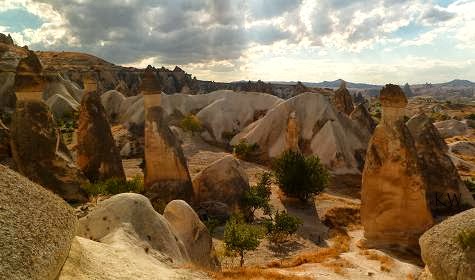The sun turned the colour of
blood as it cast a brilliant final glow across the evening sky here in the
valley of stone mushrooms. As sunset once again drew a veil across the heavens
I sat on a cushion across a low table from my sons, smoking the inevitable
hookah and drinking a brew of pleasurably spiced tea. This is what I live for,
the salutation of the dazzling morning sun that welcomes me to another day, and
the evening blaze of colours that announces not the end of day but merely a
pause, a suspension of the brightness of the light till it circles back to wake
us with its unblinking eye.
Throughout the endless weeks
of high school classes and adult speaking clubs that cluttered my waking hours
during the summer season I’ve managed to squeeze in some exciting adventures,
visiting some now recognizable and a few unfamiliar locations. I enjoyed them
all with friends or family members who’ve made the trek to enjoy the scenery,
nightlife and the variety of culture and history on offer in this fascinating
region of the world.
 I’ve been blessed with two
sons, and for the first time in a few years we were able to arrange our
schedules to meet for a couple weeks at the same time in the same place. One with time off from his job in the Far East, and the other coming from Western Europe for an extended stay before an exciting career change. We decided
to make a real holiday of it here at the crossroads of those continents by
travelling to places neither would have the opportunity to see in their
respective chosen homelands.
I’ve been blessed with two
sons, and for the first time in a few years we were able to arrange our
schedules to meet for a couple weeks at the same time in the same place. One with time off from his job in the Far East, and the other coming from Western Europe for an extended stay before an exciting career change. We decided
to make a real holiday of it here at the crossroads of those continents by
travelling to places neither would have the opportunity to see in their
respective chosen homelands.
At least three or four times
this year I’ve been over the Toros Mountains in either direction, to Bodrum to
visit friends and Konya to consider a position at the university, and
eventually returning again to witness the imposing natural grandeur of
Cappodocia. This time I was resolutely determined to investigate the ancient
Byzantine churches with their enduring iconic paintings and wall carvings, and
journey underground through the once inhabited caves that link as an endless
chain beneath those majestic monuments of the natural world.
These troglodyte
communities were
hidden below the towns and villages of this desert region as protection
from advancing armies of Romans, Arabs and Khan's Mongols in succession.
Some of these
cave systems are reputedly much older than the early Christian period generally
ascribed to them (though I don’t subscribe to the extraterrestrial theories
that some have suggested). Evidence clearly shows that Christian settlers and
hermitic communes continued the excavations, however no definitive date of
origin has yet been determined. The mystery of how and why they were first dug
still eludes archaeologists and historians, and entices scholars of ancient
culture.
The subterranean town of
Derinkuyu, just south of Nevsehir, which could sustain as many as five thousand people, is part of a network of interlaced cavern
refuges stretching over dozens of kilometres.
It contained everything the
community might have needed to survive for extended periods; living spaces and
wine presses, halls of worship and storage facilities as well as cisterns and
secreted airshafts. To provide defence during times of crisis there were large,
heavy, circular stones strategically positioned beside crucial tunnels, to be
rolled into place and secured with a locking mechanism should the need arise.
 Wandering away from the
beaten and occasionally lighted tunnels is an unnerving experience, and once or
twice discovering ourselves in a darkened and narrow channel I was quick to
shine the tiny flashlight back to the route we’d ambled down in a crouch.
Wandering away from the
beaten and occasionally lighted tunnels is an unnerving experience, and once or
twice discovering ourselves in a darkened and narrow channel I was quick to
shine the tiny flashlight back to the route we’d ambled down in a crouch. Hours
spent in challenge to discover some key to the reasons for this underground
world resulted only in a sense of bemused confusion and nervous laughter as we
attempted to find the infrequent arrows that direct intrepid visitors through the
warren of chiselled halls and passages.
Hours
spent in challenge to discover some key to the reasons for this underground
world resulted only in a sense of bemused confusion and nervous laughter as we
attempted to find the infrequent arrows that direct intrepid visitors through the
warren of chiselled halls and passages.
There are many of these
underground cities throughout Cappadocia and some are better preserved than
others, though several are as many as eighteen levels deep, containing hundreds
of rooms and labyrinthine passageways that meander up and down through eerie
cloisters. One can only imagine the bizarre lifestyle of the people who chose
such a severe existence in this wild volcanic realm with its suggestively structured landscape.
Heading back into the
sunlight from the sheltering grotto of those prehistoric caves we decided on an
afternoon hike into the open country. The fairytale mushrooms loomed above and
around seemingly distorting proportion and perspective. A ramble through the
spectacular landscape is not only breathtaking and awe-inspiring; it raises questions
of the depth of faith these anchorite communities maintained across centuries. As if caught in a dream sequence from some childhood story in all its
magical intensity we strolled and ran and leapt through this natural
wonderland.
Not content to merely admire
the rock-hewn churches from without, the next day we made our way through the
crowded turnstiles that guarded the most famous post-iconoclastic visual art of
these devout ascetics. Bishop Basil of Caesarea (nearby Kayseri) had, in the
fourth century CE instructed the residents to dig cells into the soft rock to
create churches and dwellings for the growing monastic population, and despite
attempts by later settlers dozens of these illuminating sanctuaries still
exist; albeit some have become faceless as the Islamic prohibition on graven
images persisted past the Byzantine ruling on representational drawing.
The first churches built
contained only a minimalist revelation of symbols, though after the iconoclast
debate of the 8th and 9th centuries the paintings became
vivid and representational. Having previously only seen these images in
textbooks and magazines I was taken by three-dimensionality of the figures. I
was led to believe that Byzantine art of the period was purely flat and superficial
in their semblance to reality, however these works of art displayed an
awareness of form and colour I hadn’t expected. No photograph can reveal the
depth of shadow and fullness of shape these illustrators had been capable of
portraying, more so than early Orthodox icons I’d seen in other churches.
There was a small group of
restoration artists from an Italian university finishing their daily work on
one of the magnificent wall paintings and I momentarily interrupted to ask a
few questions. One young lady was obliging and spoke some English, so we
settled into an informative conversation about the rich temperas and use of the
inherent shape of the rock basilica to design the anamorphic paintings that
covered the arches and ceiling as well as the walls. Apparently there was some
restoration in the 1970s that brought out the vibrancy in the dyes and tints
visible around us. She and her colleagues were now slowly cleaning an area
previously untouched, though she was more artist than historian her appreciation
of the meaning behind the work itself was noticeable as she told of the efforts
to maintain this historical site.
Christ on the cross, Mary
and Joseph at the manger, the Holy Trinity gathered round a feast table, the
apostles and supreme winged angels, they were all here in glorious tableau of
colour. In several of the churches we visited there were representations of
Saint George slaying the dragon, giving rise to the ancient legends that have
spread throughout Christendom of this all-conquering hero, or rather
posing questions about the adopted patron of England and the Crusaders who
crossed this enchanted land in the 12th and 13th
centuries, when the last of these rupestral churches was dug into the valley.
These colourful testimonials
to an ancient way of life, to a belief ingrained in rock, the convents and
churches, the secret underground dwellings and phenomenal sculptures that
retain their dramatic impact today, still occupy the minds of academics and
artists with their power of faith and incomparable skill of décor in this vast
curious landscape.
The complexity of this post-iconoclast art is beyond
intriguing from an ethnological point of view, and provides freedom to the
creativity of imagination that roams among these mushroom mountains like the
eagles that soar overhead into their eyries high among the peaks of the hoodoo
spires.
Returning again to these
fossilized formations above and beneath the Cappadocian plateau has merely
whetted my appetite for further travels. My heart seeks discovery of additional
evidence of continuity of revelation by turning the key of awareness that is
revealed in the natural world here in this exquisite terrain.
Yet within, I
know the art and architecture of devotion is always simply another human
attempt to explain the disclosure of self and our connection with each other
through time in a diversity of environmental conditions and cultural
expressions.
The quest wasn’t yet over
for us, more adventure awaited in the coming days, but for this moment our
hearts were filled with joy in recognition of mutual interests and the love of
life that had granted us time to share on common ground; ground that saints and
martyrs, heroes and villains had trod before us.
The shadowy subterranean
trails of art that cross this historic site were merely paths on the way to
enlightenment for them and now we too.
 Their lives, and what they left for us
to find are a part of our own history, and so we acknowledged their lingering
presence as old friends, as ancestors whose blood unites a family. For blood is
the sacred essence that sustains life, a life that continues to remind us who
we are and who we have been, as beings in process of becoming, fingertips reaching
eternally toward the risen sun.
Their lives, and what they left for us
to find are a part of our own history, and so we acknowledged their lingering
presence as old friends, as ancestors whose blood unites a family. For blood is
the sacred essence that sustains life, a life that continues to remind us who
we are and who we have been, as beings in process of becoming, fingertips reaching
eternally toward the risen sun.
* * *















